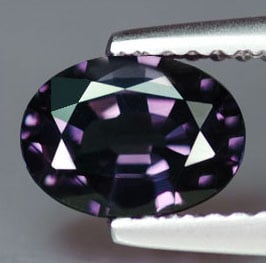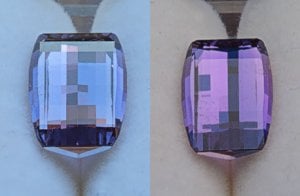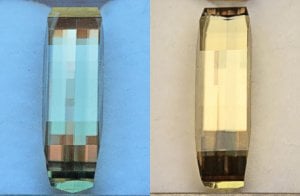zeolite
Brilliant_Rock
- Joined
- Aug 13, 2008
- Messages
- 619

The pictures posted yesterday was my first successful attempt at merging both photographs into one .jpg picture. I have another probably full spectrum fluorescent bulb to try for the "daylight" picture. Yes, different fluorescent bulbs will give different results.Date: 9/4/2008 12:57:29 AM
Author: Richard M.
zeolite,
Nice stones. I just received a nice rough parcel of the Wandanyi, Kenya material shown in your image #2.
Fluorescent light covers a huge color temperature range. My color change garnets often show an entirely different color under fluorescent than in natural sunlight, even so-called ''daylight'' fluorescents in the 5,000-6,000 K range. I''ve always considered incandescent light around 300 K and sunlight between 10 a.m. and 4 p.m. the only real way to illustrate color change in gems.
I did my GIA colored stone courses when CC garnets were still rare and not well studied. Does GIA currently make any color temperature recommendations for viewing/grading/photographing CC gems? I haven''t been able to find out.
Richard M.

Wow, that''s a strong change. You should be proud to have such a fine, rare gem!Date: 9/4/2008 6:04:37 PM
Author: Pandora II
And in incandescent light:
It shows a bit of a purple flash as well. I''ve been taking some photos but they''re not great sadly. I''ll post one when I catch it right. These photos are the vendor''s.

A normal way to set the white balance in a photo is to set whites in the picture to pure white.Date: 9/4/2008 1:55:54 AM
Author: GemRite
Hey Zeolite, Nice stone by the way. You can try correcting the color by using the whitebalance and a sheet of white paper. I know noticed on your photos the white back grounds were showing the color of the light. Reddish tone for incadescent and the light blue for natural or flourescent. This will help showing the color of the pale green stone better. I appreciate you charing the stones you have. I would post my color change garnets expect i would be breaking posting policy. My color change stones go from pinkish purple or pink to a yellow or orange color. I think the color change i have are unusual they come from the Tunduru region of Tanzania, but the Madagascar material is nice as well. Red to a nice blue. I also have a friend who has a piece of Madagascar CC garnet rough that is colorless (white) in one light and a red color in the other. The only one I have ever heard of or seen. Super rare. We all know of the red to greens and the red to blues-purples. But the other color change we don''t see much of is nice as well. Pink to yellow or pinkish purple to orange and even the white to red. Nice that we have diversityI would like to know your thoughts on other color changes as well.
Date: 9/4/2008 12:16:04 PM
Author: zeolite
I don''t know what GIA''s recommendation is presently. I do have a chemical analysis of the spinel. and possibly the sapphire, done by Dr. Shigley of GIA, about 1990. Without looking up the report, I seem to remember that traces of vanadium contributed to the color change effect.
I tried mine with one of them, but the only way it shows the colour in the photo is slightly overcast daylight. Any sun starts to bring out the pink colour.Date: 9/5/2008 11:44:10 AM
Author: Richard M.
Date: 9/4/2008 12:16:04 PM
Author: zeolite
I don''t know what GIA''s recommendation is presently. I do have a chemical analysis of the spinel. and possibly the sapphire, done by Dr. Shigley of GIA, about 1990. Without looking up the report, I seem to remember that traces of vanadium contributed to the color change effect.
Vanadium seems to be present in most color-change gems other than alexandrite. It''s occurrence is widespread in Africa which probably accounts for the many color-change garnet and corundum occurrences there. It is even an isomorphous replacement for chromium in Zambian and some other African emeralds.
As for my lighting question, it seems to me that images of CC gems can be rather misleading without specifics about the type of lighting used, combined with an understanding on the part of the consumer as to why it can make a big difference. If you go to gem shows you''ll see vendor after vendor demonstrating color change with a ''daylight'' Ott lamp. Yet my own tests have shown the actual daylight color of stones is very different more often than not.
These days, when a lot of gem trading is done with images on the internet, it seems to me that GIA or maybe the Lab Harmonization group should set some international lighting standards for judging color change, not just simply ''incandescent'' and ''fluorescent.'' That way a buyer in Scranton, say, using the same lighting as a seller in another location, should expect the gem to look the same.
I''ve refrained from trying to sell my CC stones because there are big misunderstandings about them on the part of consumers. I just trashed a large number of images that took me long hours to make because they showed different background colors just like yours. Thanks for your contribution to better understanding about that. I felt certain potential clients would suspect some photographic trickery if I used similar images.
Richard M.
I''ve given a lot of thought about your comments of fluorescent vs sunlight on color change (c/c) gems.Date: 9/5/2008 11:44:10 AM
Author: Richard M.
Date: 9/4/2008 12:16:04 PM
Author: zeolite
I don''t know what GIA''s recommendation is presently. I do have a chemical analysis of the spinel. and possibly the sapphire, done by Dr. Shigley of GIA, about 1990. Without looking up the report, I seem to remember that traces of vanadium contributed to the color change effect.
Vanadium seems to be present in most color-change gems other than alexandrite. It''s occurrence is widespread in Africa which probably accounts for the many color-change garnet and corundum occurrences there. It is even an isomorphous replacement for chromium in Zambian and some other African emeralds.
As for my lighting question, it seems to me that images of CC gems can be rather misleading without specifics about the type of lighting used, combined with an understanding on the part of the consumer as to why it can make a big difference. If you go to gem shows you''ll see vendor after vendor demonstrating color change with a ''daylight'' Ott lamp. Yet my own tests have shown the actual daylight color of stones is very different more often than not.
These days, when a lot of gem trading is done with images on the internet, it seems to me that GIA or maybe the Lab Harmonization group should set some international lighting standards for judging color change, not just simply ''incandescent'' and ''fluorescent.'' That way a buyer in Scranton, say, using the same lighting as a seller in another location, should expect the gem to look the same.
I''ve refrained from trying to sell my CC stones because there are big misunderstandings about them on the part of consumers. I just trashed a large number of images that took me long hours to make because they showed different background colors just like yours. Thanks for your contribution to better understanding about that. I felt certain potential clients would suspect some photographic trickery if I used similar images.
Richard M.


The experts I''ve studied seem to agree the only accurate and measurable way of comparing light sources is the spectral output of their color. So far as I know, no current gemological authority has addressed that matter in a practical way that helps in transacting colored gem business.
